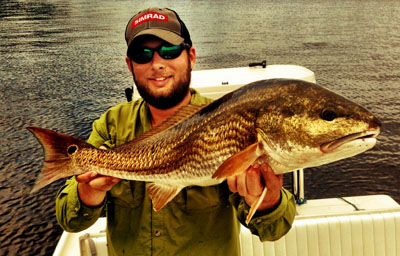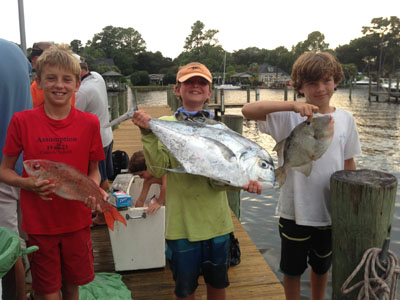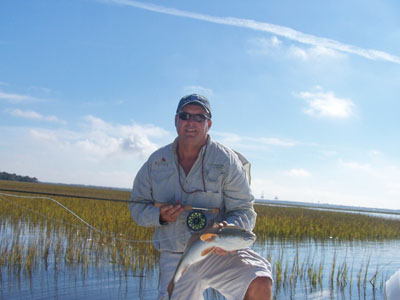Flood tides bring redfish for stealthy fishing

By Nathan & Ted Miller
With the Jaguar’s regular season and college football kicking off, September marks a great time of the year to be in Northeast Florida. Air temperatures should begin to cool slightly. Football fans make their way to their favorite college town on Saturdays, or tailgating along the north bank of Jacksonville on Sundays.
September also is a time when unusually high tides coincide with the new and full moons. This event we call flood tides.
The new moon will be on September 5th of this year followed by a full moon 14 days later. During this period of this particular month, we will see higher-than-normal high tides. Redfish will stage in the creeks during the rising tides until the high tides reach the peak, allowing the fish to feed in areas of the marsh typically not accessible.
Marsh life such as snails and fiddler crabs that live in these areas rarely see tidal water. But this month, they will. And redfish will be hungry and looking for them.
When targeting tailing reds, some of these areas are accessible by foot. Drive along the roads that run adjacent to these marshes during the final stage of the incoming tides and look for areas that are beginning to flood. Park your car, grab your gear, and walk in.
If you fish these areas by boat, follow the incoming tides up the narrow creeks until the tide reaches the highest point. Many of these flooded areas will be up against hardwoods that rarely see tidal water during the year. These oak trees thrive in the higher elevation, so the closer you get to the trees, the better chance you have in finding the targeted areas.
As you push quietly up the creeks towards your destination, stop periodically, look and listen. Many fish will begin feeding during the final stage of the incoming tides and you may see a few before the tide is at the highest point.
Once you find a spot that looks good, the hunting begins.
Remain on the vessel. Look for any movement or ripples in the water. You may see water pushing from a moving fish. Look for moving grass which indicates a fish swimming along. Or you may see what you came for…a tail waiving several inches in the air as the fish feeds along the hard bottom.
Once you confirm there are fish feeding or moving around the area, the fun begins.
There are a couple of ways you can position yourself to make a cast. You can either push pole across the flooded marsh and cast from the boat or exit the vessel and walk around.
If you wade, it is important to make sure you are wearing appropriate clothing. Boots or tennis shoes with long pants will allow you to walk around without getting irritated by the marsh grass. And make sure you ease yourself into the water and walk carefully. There are many depressions along the bottom that can drop several feet in depth.
As you are hunting for tailing reds, walk slowly. The feeding fish can be very wary of any movement or foreign sound along the flat. You are in their home so it does not take much to alert your presence. Just because you do not immediately see a fish pushing or tailing does not mean they are not there. Often times while you are walking, a fish will spook several feet away and water will erupt. Your chance at that fish is usually done.
Once you find a tailing red, slowly move to a comfortable casting distance, but not too close. Make your cast beyond the fish and slowly retrieve until you think your bait is in close proximity to the feeding fish and can be seen or the scent can be picked up.
Stop your retrieve. Twitch, twitch and twitch your bait again. Let it sit a few moments. Twitch again. If nothing happens, retrieve slowly and recast.
When casting or twitching your bait, it is important to be aware of where your line is in relation to the fish. Main line touching or running across the fish’s tail or back will most certainly spook them.
We find that a spinning reel outfit with a 7’ or 7.5’ lightweight rod works well. A 20-30 lb. braid main line for sensitivity and abrasion strength should be plenty. Connect the main line to the 15 – 20 lb. fluorocarbon leader using a double unit knot. We also find that rigging a gulp bait or live shrimp weedless hook can ensure you spend more time fishing and less time hooked up to grass.
Local experienced flood tide anglers have also been known to live by the rule of only taking one fish per flat per day. Even if your intention is to release subsequent fish, catch one and move one. Leaving a school of tailing reds to hunt another day demands discipline, but is sound advice.
The size limit on redfish in Northeast Florida is no less than 18” and no more than 27” in total length. The aggregate limit is 2 fish per person, or a maximum limit of eight fish per vessel. Anyone between the ages of 16 and 64 require a saltwater fishing license.
Fishing license exemptions also include:
• You are a Florida resident certified as totally and permanently disabled and you possess a Florida Resident Disabled Person Fishing Certificate.
• You are a resident who is a member of the Armed Forces of the United States, you are not stationed in this state, and you are home on leave for 30 days or less, upon submission of orders.
Redfish numbers have improved greatly since the approval of Amendment Three of the Florida Constitution back in 1994 (aka, Florida net ban). It is great to witness this fishery thriving as it is today.
Although the limit has recently been increased to two fish per person, you don’t need to harvest two. We find catching and releasing the second fish to fight another day can be more enjoyable.








